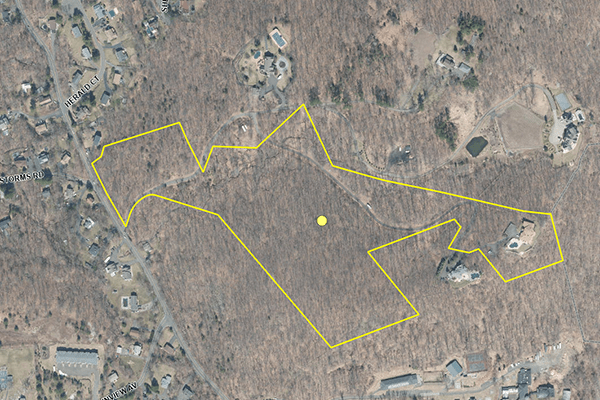|
RCBJ-Audible (Listen For Free)
|
Blinn Family Proposing To Build Three Houses On Ridge Line Of West Hook Mountain In Valley Cottage
By Tina Traster
Residents who fight against housing developments typically take aim at large-scale or dense projects that threaten neighborhoods with increased traffic and other disruptions to a street or neighborhood. But a landowner who’s angling to build three houses is meeting with resistance from neighbors, town and county planners, the Village of Upper Nyack, and hikers because the proposal is asking for permission to construct three houses on the environmentally sensitive Palisades ridge line of West Hook Mountain in Valley Cottage.
The Blinn family, who live at 2 Old Stone Road, want to divide their 27.7-acre lot to include three new houses – two on the ridge line and one along Christian Herald Road. The entire acreage sits in what Clarkstown defines as an “R-160” zone, or a “conservation density residence district.” This zoning, established 40 years ago, was designed to provide protection to the town’s scenic resources such as wooded areas, steep slopes, open spaces, and scenic vistas.
This does not mean that development is strictly prohibited but it is restricted by these protective parameters.
In this case, the Blinns have a right, because of the total acreage, to subdivide the property and construct three houses on four-acre lots. But not for the configuration they have in mind. The Blinns live in a house on the ridge on the far northeastern corner on the lot. Rather than propose two more houses spread out across the acreage, the applicant wants to “cluster” two more houses to the southwest to take advantage of Hudson River views. And this is why the application, which has been pending in different forms before Clarkstown’s planners since 2008, is thorny.
At a Clarkstown Planning Board meeting last week, board members raised concerns over clearcutting or thinning of trees, as well as a host of environmental issues on the proposed development, which overlooks Camp Ramah and Nyack High School to the south, and Route 9W and the Village of Upper Nyack to the east. The Blinns need the Planning Board to sign off on the request to “cluster” the two houses, before it can proceed to the Town Board for approval. The applicant argues that clustering the houses in exchange for donating land for conservation is a fair deal for the town, a good-will trade that balances development with preservation.
Board Chairman Gil Heim and the other members did not seem to agree; the board took exception to the suggested concept of creating a “conservation easement exception” to a conservation easement.
“I can’t see the board agreeing to the exception area,” said Heim.
Essentially, Heim was calling out the contradiction of portraying a swath of land as forever wild if a portion is carved out for substantial tree removal. In all the project calls for the removal of nearly 150 trees, with no requirement to replant based on the number of remaining trees on the balance of the acreage. The “exception” carveout allows for removal of up to 50% of the trees in the exception area.
Board members, who were polled and unanimously opposed to the concept, cited concern that tree cutting has the tendency to “creep” beyond boundaries and the allocated percentage.
At issue, is the view.
The developer wants to cut trees to give the prospective homeowners a grand view of the Hudson River, but this comes at a price for everyone else who will potentially see the houses atop the mountain without screening, altering the prized scenic vista. A unique provision of the R-160 zoning is that it provides protection for the “enjoyment of scenic vistas and natural areas to residents and visitors,” balancing those rights against those of the property owner.
The County Planning Department in its review of the project said, “This exception area must not be permitted.” The department also raised alarm over razing “core forest,” or interior forest areas that provide habitat to support a diversity of forest species including songbirds.
A third house is proposed where Storms Road meets Christian Herald. The plan calls for widening the private, narrow Old Stone Road to 30-feet wide, making it a public road. Objections from board members and residents were also raised about the destruction of trees ruining the vista from the wooded lot off Christian Herald Road, along with fear of added flooding on a road that is frequently inundated and difficult to traverse in heavy rains and snows.
The developer is proposing to dedicate one lot for drainage/stormwater retention issues, and one three-acre lot to the town for open space preservation as part of the cluster approval.
The application echoes with residents who brought to light illegal tree cutting that took place on a homeowners’ property, also on Stone Road off West Hook Mountain. In 2021, Valley Cottage homeowner Edward Teitel built an illegal addition on his house and allegedly cut down a swath of more than 100 trees on both his own property and on town land.
After the Clarkstown took Teitel to court, Town Justice Scott Ugell agreed to a global settlement that included a payment of $6877 to reimburse the town for the work attorneys, engineers, building inspectors, and others have spent on the case.
Teitel did not admit to felling trees, but the agreement included a replacement of 125 trees to populate the boundary between the homeowner and town-owned property.
“As most people in the Save West Hook Mountain! FB Group know… some people are willing to cut down trees that aren’t even theirs in order to maximize the views, so this is a very sensitive subject that needs a lot of attention from the Planning Board,” said Marvin Baum, who led the effort to bring the homeowner into compliance.
The applicant has agreed to granting a 10-foot wide right-of-way to the County for a hiking trail. The New York-New Jersey Trail Conference wants to reroute the Long Path from Route 9W to Stone Road and through town-owned land toward Hook Mountain.











